NVIDIA Tegra X1 Preview & Architecture Analysis
by Joshua Ho & Ryan Smith on January 5, 2015 1:00 AM EST- Posted in
- SoCs
- Arm
- Project Denver
- Mobile
- 20nm
- GPUs
- Tablets
- NVIDIA
- Cortex A57
- Tegra X1
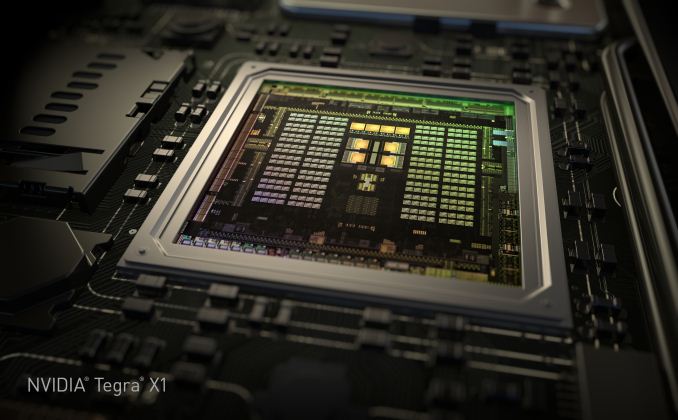
In the past few years, we’ve seen NVIDIA shift their mobile strategy dramatically with time. With Tegra 2 and 3, we saw multiple design wins in the smartphone space, along with the tablet space. These SoCs often had dedicated GPUs that were quite unlike what we saw in NVIDIA’s desktop and laptop GPUs, with a reduced feature set and unique architecture. However, with Tegra K1 we saw a distinct shift in NVIDIA’s SoC strategy, as the Tegra K1 was the first mobile SoC to achieve parity in GPU architecture with desktop GPUs. In the case of the Tegra K1, this meant a single Kepler SMX which made for truly incredible GPU performance. However, in the time since we’ve seen companies like Apple release new SoCs such as the A8X, which managed to bring largely similar performance with less power.
NVIDIA of course is never content to stay idle for too long and let themselves be surpassed, which has led to the company developing their Tegra SoCs on a roughly yearly cadence. In NVIDIA’s development timeline, 2014 brought us the Tegra K1-32, the company’s first SoC to integrate a modern high-performance GPU architecture (Kepler), and later on the TK1-64, a K1 with NVIDIA’s own in-house developed ARMv8 Denver CPU in place of the 32bit ARM A15 CPU.
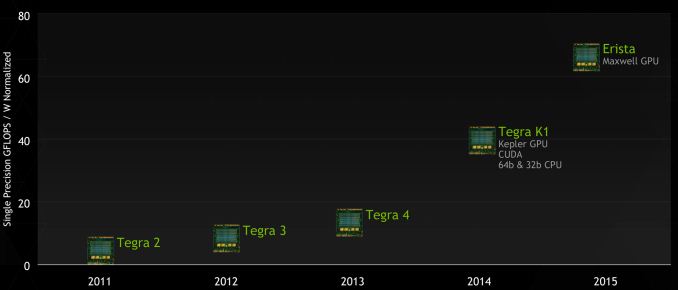
NVIDIA's GTC 2014 Tegra Roadmap
2014 also brought a revision to NVIDIA’s public Tegra roadmap: for 2015 NVIDIA would bump the previously announced Parker SoC and release a new in its place, Erista. This schedule change ended up being quite a surprise due to the fact that NVIDIA had up until this time released their roadmaps roughly 2 years out, whereas Erista was put on the map less than a year before it was to be announced. More unusual, NVIDIA offered up minimal details of Erista; it would be powered by a Maxwell GPU with no additional information on the CPU or manufacturing process. Parker on the other hand – NVIDIA’s planned Denver + Maxwell + 16nm FinFet part – fell off the schedule, with NVIDIA not officially canceling it but also saying little else about it.
Now in 2015 and with the launch of the Tegra X1, we can finally begin putting the picture together. Erista as it turns out is something of a rapid release product for NVIDIA; what had been plans to produce a 16nm FF part in 2015 became plans to produce a 20nm part, with Erista to be that part. To pull together Erista NVIDIA would go for a quick time-to-market approach in SoC design, pairing up a Maxwell GPU with ARM Cortex A57 & A53 GPUs, to be produced on TSMC’s 20nm SoC process.
CPU
We’ll kick off our look at Erista then with a look at Erista’s CPUs, where one of the bigger surprises in Erista is the CPU configuration. While Tegra K1 had a version with NVIDIA’s custom Denver core for the CPU, NVIDIA has elected to use ARM’s Cortex A57 and A53 in the Tegra X1. The A57 CPU cluster has 2MB of L2 cache shared across the four cores, with 48KB/32KB L1s (I$+D$) per core. The A53 cluster has 512KB of L2 cache shared by all four cores and 32KB/32KB L1s (I$+D$) per core. NVIDIA representatives stated that this was done for time to market reasons.
However, rather than a somewhat standard big.LITTLE configuration as one might expect, NVIDIA continues to use their own unique system. This includes a custom interconnect rather than ARM’s CCI-400, and cluster migration rather than global task scheduling which exposes all eight cores to userspace applications. It’s important to note that NVIDIA’s solution is cache coherent, so this system won't suffer from the power/performance penalties that one might expect given experience with previous SoCs that use cluster migration.
Although cluster migration is usually a detriment to power and performance (especially without a cache coherent interconnect), NVIDIA claims that Tegra X1 significantly outperforms Samsung System LSI’s Exynos 5433 in performance per watt with 1.4x more performance at the same amount of power or half the power for the same performance on the CPU. It's likely that this difference comes from optimizing the implemented logic and differences between Samsung and TSMC 20nm processes rather than differences in thread management. NVIDIA continues to use System EDP (Electrical Design Point) management to control throttling and turbo rather than ARM's IPA (Intelligent Power Allocation) drivers, and in general it seems that while the CPU architecture is ARM's reference design it's quite clear that everything else is distinctly NVIDIA in design.
All of this of course raises the question of where’s Denver, and what is to happen to it? The use of the ARM Cortex A57 and A53, as NVIDIA tells it, was based on a time-to-market decision, and that NVIDIA could bring an off-the-shelf Cortex-based SoC to the market sooner than they could another Denver SoC. On the surface there is at least some evidence to agree with this, as NVIDIA would be able to buy a 20nm design from ARM versus spending the time porting Denver over from TSMC’s 28nm process to their 20nm process. At the same time however integrating an ARM CPU core into an SoC is not an easy task – logic LEGO this is not – so it’s hard to say whether this actually saved NVIDIA much time.
In any case, much like the still in the dark Parker design, NVIDIA is holding their cards close to their chest and hinting that Denver will still be in future generation products. If Parker is still part of NVIDIA’s plans – and they are without a doubt working on some kind of 16nm FF Tegra SoC – then we may still see Denver as part of the original Parker plan. Otherwise at this point while there’s no reason not to believe NVIDIA about the fate of future Denver SoCs, it’s anyone’s guess when we might see it again.
Uncore
Outside of the CPU and GPU, NVIDIA has also dramatically improved the rest of Tegra X1 in comparison with Tegra K1. We see a move from 64-bit wide LPDDR3 to 64-bit wide LPDDR4 on the memory interface, which improves peak memory bandwidth from 14.9 GB/s to 25.6 GB/s and improves power efficiency by around 40%. In addition, the maximum internal display resolution moves from 3200x2000 at 60 Hz to 3840x2160 at 60 Hz with support for VESA’s display stream compression. For external displays, we see a significant improvement with support for HDMI 2.0 and HDCP 2.2, which means that 4K60 is supported in contrast with the Tegra K1, which only supported 4K30.
The ISP is largely similar to the one we see in the Tegra K1 when it comes to feature set, but JPEG encode and decode rate is now five times as fast, going from 120 MP/s to 600 MP/s. For video encode and decode, we see support for 4K60 H.265 and VP9, with support for 10 bit color on decode on H.265. In addition to support for new codecs in the hardware blocks, we see that H.264 and VP8 now support 4K60, a notable improvement over the 4K30 that was the maximum for Tegra K1. We also see that the storage controller now supports eMMC 5.1 for faster storage performance.


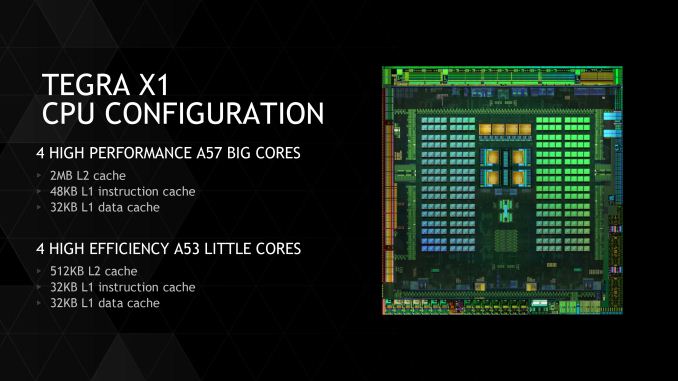
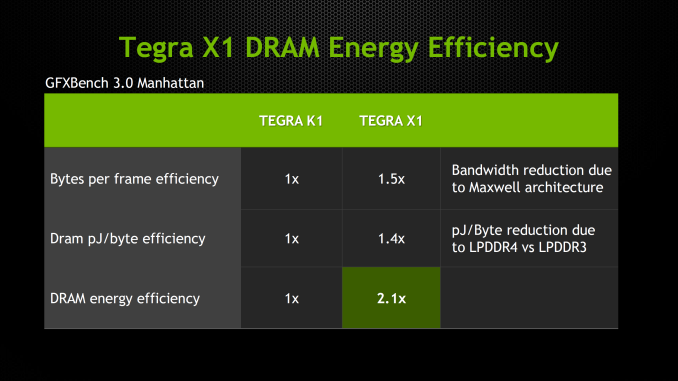
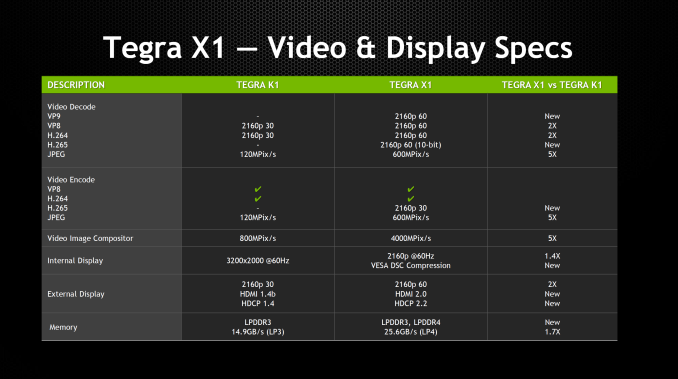








194 Comments
View All Comments
esterhasz - Monday, January 5, 2015 - link
Only one of the three devices you mention runs on Denver cores (Nexus 9) and performance reviews have been very uneven for that device, to say the least.PC Perv - Monday, January 5, 2015 - link
Oh I don't know, man. All I know is that every Galaxy tablet has either Exynos or Snapdragon in it.OK, maybe not all of them but I do not think Tegra is in any of them.
kron123456789 - Monday, January 5, 2015 - link
Yeah but it's either Exynos 5420 or Snapdragon 800/801.darkich - Monday, January 5, 2015 - link
Well you dont know much then.Tegra K1 got to market along with the Snapdragon 805 and Exynos 5433.
Out of those three, the K1 took most design wins .
Dont compare the K1 with other Snapdragon and Exynos chips ,and the sea of MTK, Rockchip, Allwinner and Intel atoms chips.
It is an entirely different market
darkich - Monday, January 5, 2015 - link
Clarification- by "most design wins" I was referring to tablet market of courselucam - Wednesday, January 7, 2015 - link
Let's say 2 since one is Nvidia reference tablet and of course it always wins.chizow - Monday, January 5, 2015 - link
@jcwalla, I'm not sure there's "no fruit" from their investment, they are now on their 6th major iteration of Tegra (1-4, K1, X1) with a major variant in Denver K1 and while their marketshare and Tegra revenue won't reflect it, they are clearly the market leader in terms of performance for Android SoCs while going toe-to-toe with the monstrous Apple. Not bad, considering I am positive Apple is probably investing more than Nvidia's yearly revenue in keeping their SoC's relevant. ;)Breaking into an established market and growing a business from scratch is hard, but Nvidia clearly sees this as an important battle that needs to be fought. As a shareholder and tech enthusiast, I agree, in 10 years there's no doubt I would want an Nvidia GPU in whatever handheld/thin device I am using to power my devices.
The problem is that Nvidia lacks the "killer app" that really distinguishes their SoC over others. Even Apple is beginning to understand this as there's nothing on iOS that remotely takes advantage of the A8X's overkill specs. Nvidia needs to grow the Android/mobile gaming market before they really distinguish themselves, and from what I have seen, THAT is their biggest problem right now.
jwcalla - Monday, January 5, 2015 - link
Tegra is an important LOB for NVIDIA, but I'm more talking about how Denver has been received. When it was in the rumor stage, the scuttlebutt seemed to be about how they were going to marry ARMv8 CPU cores with discrete cards and take over the HPC world, etc. Then that got filtered down to "Yeah Denver is just a custom ARMv8 core for Tegra." (Which isn't earth-shattering; Qualcomm and Apple had been doing custom designs for a long time.) And now it doesn't seem like Denver is really anything special at all.But did it not involve a lot of hype, money, and time over all those years?
chizow - Monday, January 5, 2015 - link
Well, I think that HPC embedded ARM core in a massive GPGPU is still a possibility, but again, you're looking a very focused usage scenario, one which I think was pushed back by the process node delays at 20nm and now 16nm FinFET. We have seen since then Nvidia's roadmaps have changed accordingly with some of the features migrating vertically to new generation codenames.But the important point is that Nvidia's investment in mobile makes these options and avenues possible, even if Tegra isn't lightning up the P&L statements every quarter.
Yojimbo - Monday, January 5, 2015 - link
NVIDIA seems to be marrying themselves to IBM in the HPC space, but maybe ARM HPC is a different segment than what PowerPC occupies? I don't know. But IBM has a lot of experience and expertise in the area. Maybe NVIDIA thought they were biting off more than they could chew, maybe the Denver CPU just wasn't performing well enough, or maybe the opportunity with IBM came along because IBM realized they could benefit from NVIDIA as they didn't have anything to compete with Intel's Xeon Phi, and NVIDIA jumped at it.